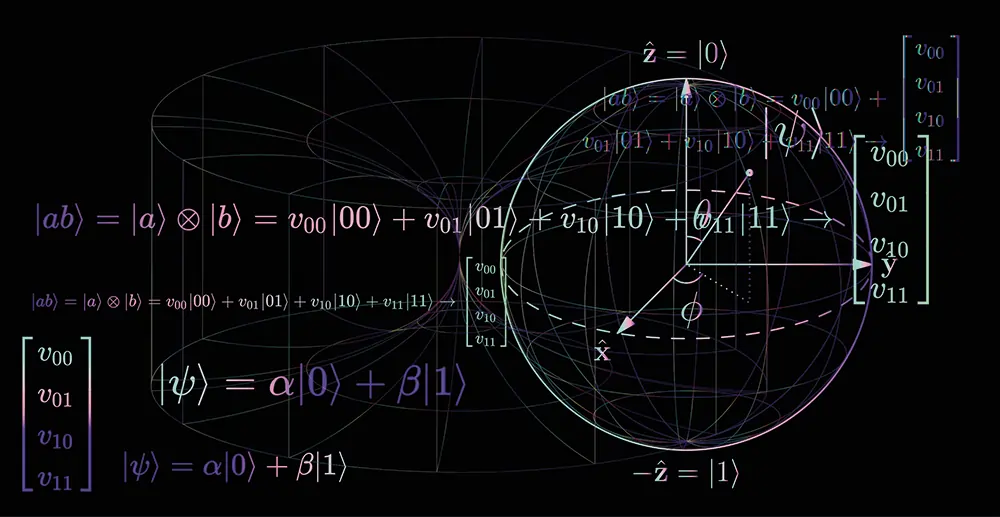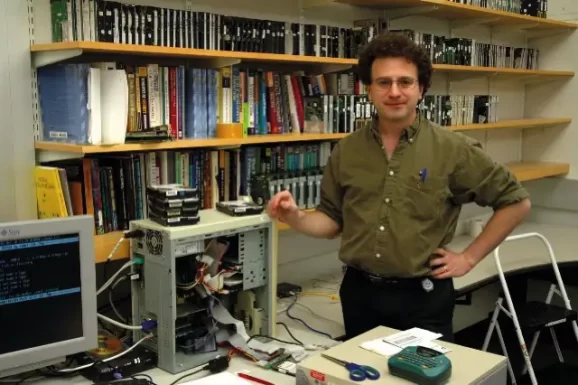Where are we on the quantum leap?

John E. Kaye
- Published
- Home, Technology, Uncategorized

While large-scale quantum computing remains a long way off, other types of quantum technology are already making an impact – Alex Katsomitros separates the facts from the sci-fi with two leading experts
In 1994, the 35-year-old American mathematician Peter Shor discovered an algorithm that would change information science forever. Shor used the principles of quantum physics to create an algorithm that solved a mathematical process called “prime factorisation” faster than any classical algorithm running on an ordinary computer. The implications were enormous. Prime factorisation is used in online encryption, and therefore a computer using quantum mechanics could break most cryptographic codes that underpin e-commerce and other online interactions. Quantum computing, hitherto a mere thought experiment, had turned into a potential technological breakthrough.
Quantum dreams
Nearly thirty years later, quantum technology continues to fascinate scientists and technologists. A range of emerging technologies tap into quantum mechanics to perform tasks nearly impossible to achieve with classical physics. While normal computers use binary digits, known as bits, to operate, quantum computers use quantum bits (qubits) that can exist in multiple states simultaneously, exponentially increasing their calculating capabilities. Crucially, they can simulate complex systems, enabling researchers to understand previously unfathomable phenomena, such as molecule behaviour.
The technology’s huge potential and groundbreaking policy implications, first explored during a shared flight from Jerusalem to New York, prompted Chris Hoofnagle, an academic from the UC Berkeley School of Law, and Simson Garfinkel, a computer scientist and inventor, to write Law and Policy for the Quantum Age, a seminal book on the coming quantum era. Despite the title, the authors suggest that we should be taking enthusiastic forecasts with a pinch of salt, particularly about quantum computing; its future, they acknowledge, is replete with too many ifs and buts. “People have been hyping up the opportunities for quantum computing, but right now its main use is getting research papers published and attracting funding,” says computer scientist Garfinkel via Zoom, adding: “Quantum computing is similar to high-energy physics in that a lot of money is being spent, but it will take a lot of
time before we see a real commercial payoff.”
Indeed, like nuclear fusion and flying cars, large-scale quantum computing remains a chimera whose advances seem imminent enough to make futurists drool, yet still too far away to be taken seriously. Its limitless potential lends itself to sci-fi daydreaming and some pretty far-out thinking. For instance, new age guru Deepak Chopra suggests that our DNA is a quantum computer and extols the powers of “quantum healing”, while Hollywood movies arm villains with quantum superpowers. And yet, the technical challenges remain insurmountable. Existing quantum computers only have a small number of qubits, making them practically useless for real-world applications. Building large quantum computers is a notoriously difficult engineering feat, given the extremely low temperatures and energy costs required. The largest one, IBM’s Osprey, features just 433 qubits, although the company expects to build a 1,000-qubit processor by the end of 2023. Qubits are vulnerable to the slightest change in their environment, easily losing their magic properties. More worryingly, three decades since Shor’s discovery, few similar algorithms have been developed to prove the usefulness of quantum computing.

scientific breakthroughs”
Simson Garfinkel, computer scientist and inventor
These obstacles have convinced sceptics that quantum computing is just too hard a nut to crack. For their part, Hoofnagle and Garfinkel believe that the opportunities for other quantum technologies are more mature. Sensors using quantum technology, such as magnetometers and gravimeters, can achieve unprecedented precision in measuring physical quantities, revolutionising geology, navigation, drug discovery and medical imaging. As they note in the book, quantum sensing is already paying off, given its simpler technical requirements; one example is magnetic resonance imaging (MRI), a technology that has already saved thousands of lives.
Hoofnagle and Garifnkel are optimistic that in the next decade we will have quantum computers large enough to solve real-life problems, but also acknowledge that we are far from any major breakthroughs, despite the efforts of the world’s largest tech companies. Google has developed a quantum computer able to perform calculations that would take the best non-quantum supercomputers nearly half a century to perform, while Microsoft expects to build a quantum supercomputer within ten years. “Microsoft has said that they expect to build a quantum supercomputer, but they’ve also said that they don’t know the technology that they will use,” says Garfinkel, adding: “IBM has published a roadmap, but if you look at their roadmap it requires unknown scientific breakthroughs.”
Instead, they predict that disenchantment with quantum computing leading to reduced investor interest, known as “quantum winter”, is a likely scenario. “A lot of the energy and money being put into quantum computing is based on the idea of dramatic improvements in general-purpose quantum computers, quantum cryptanalysis and machine-learning. We think that those are unlikely to pan out before 2030 and therefore there will be a significant drop in investment” says Garfinkel.

A new Big Brother?
In a way, Shor’s discovery early in the history of quantum computing was unfortunate, the authors note, given that it caused cryptanalysis to overshadow other applications, such as drug development. If ever built, large quantum computers may undermine widely used encryption standards and crack most encrypted messages, warn Hoofnagle and Garfinkel. However, they suggest that we should not take apocalyptic scenarios too seriously, given that malign actors would only focus on high-value targets, while countermeasures are already in sight.
An even bigger danger arises from firms whose bread and butter is data monetisation. If social media networks can leverage the power of algorithms to provide dopamine hits and even influence our voting preferences, higher-dimensional analyses offered by quantum technology will render our right to privacy practically unenforceable. As the authors note, “Quantum sensing, in fact, might be the technology that fundamentally erodes what it means to be an individual.” The implications for law enforcement are also enormous. Policemen may be able to justify “Stop and Frisk” searches based on the fact that “analysis of lawfully acquired data observed in public is fundamentally no different than observing a bulge in a person’s pocket from a handgun,” Hoofnagle and Garfinkel argue. Should we be more worried about governments than private corporations? Both, given that privacy protection is more of a process rather than a single event, says Hoofnagle, an expert on tech law. “Privacy threats are dynamic: they will first manifest themselves in cutting-edge, intelligence and military only capabilities,” he remarks, adding: “But we know from history that innovations in intelligence eventually become democratised, typically first to law enforcement, and then to the private sector.”
As for legislation, the authors believe that the US will follow its usual laissez-faire approach: allow innovation to be deployed despite possible privacy threats, and intervene afterwards. “We will want many deeply invasive forms of quantum sensing, but in contextual environments where people are protected,” says Hoofnagle. “For instance, higher resolution body scanning is welcome in medical diagnosis, but problematic in interrogation.”
Another brick in the geopolitical wall
Quantum technology is increasingly becoming a valuable pawn on the geopolitical chessboard. China is already publishing more papers on the subject than any other country. The prospect of non-Western “quantum dominance” that would put paid to the West’s technological advantage is already discussed in military circles. “Many nations will find ways to build quantum technologies. These nations may be copycats, they may steal innovations, and so on. But stopping them is tricky because there are commercial components that support quantum-level precision. That is, components are in the commercial world; they are not limited to labs,” Hoofnagle says, arguing that the US can get there first: “We can achieve superiority and retain it. To do so, the government must fund basic research (both Presidents Trump and Biden are doing this) and pursue open immigration policy. Students earning PhDs in quantum-related fields ought to also get a green card!”
The issue is not purely theoretical. As the authors note, once governments have functioning quantum computers, they may deploy them to simulate nuclear weapons, which means that paradoxically enough quantum computers might accelerate the development of nuclear weapons with fewer barriers-to-use. Would that justify calls for a pause on certain uses of quantum technology? Hoofnagle believes that the advantages of free deployment surpass the downsides. “There are many upsides to deep military and intelligence integration of quantum technologies. For instance, many American weapon systems may function incorrectly in the presence of electronic warfare, like GPS jamming,” he says, adding: “Military quantum sensing systems may be the difference between intercepting an intercontinental ballistic missile or not. The real dangers are coming from rogue militaries that will use the technology to model biological and chemical weapons.”

Chris Hoofnagle, academic, UC
Berkeley School of Law

Sign up to The European Newsletter
RECENT ARTICLES
-
 Europe emphasises AI governance as North America moves faster towards autonomy, Digitate research shows
Europe emphasises AI governance as North America moves faster towards autonomy, Digitate research shows -
 Surgeons just changed medicine forever using hotel internet connection
Surgeons just changed medicine forever using hotel internet connection -
 Curium’s expansion into transformative therapy offers fresh hope against cancer
Curium’s expansion into transformative therapy offers fresh hope against cancer -
 What to consider before going all in on AI-driven email security
What to consider before going all in on AI-driven email security -
 GrayMatter Robotics opens 100,000-sq-ft AI robotics innovation centre in California
GrayMatter Robotics opens 100,000-sq-ft AI robotics innovation centre in California -
 The silent deal-killer: why cyber due diligence is non-negotiable in M&As
The silent deal-killer: why cyber due diligence is non-negotiable in M&As -
 South African students develop tech concept to tackle hunger using AI and blockchain
South African students develop tech concept to tackle hunger using AI and blockchain -
 Automation breakthrough reduces ambulance delays and saves NHS £800,000 a year
Automation breakthrough reduces ambulance delays and saves NHS £800,000 a year -
 ISF warns of a ‘corporate model’ of cybercrime as criminals outpace business defences
ISF warns of a ‘corporate model’ of cybercrime as criminals outpace business defences -
 New AI breakthrough promises to end ‘drift’ that costs the world trillions
New AI breakthrough promises to end ‘drift’ that costs the world trillions -
 Watch: driverless electric lorry makes history with world’s first border crossing
Watch: driverless electric lorry makes history with world’s first border crossing -
 UK and U.S unveil landmark tech pact with £250bn investment surge
UK and U.S unveil landmark tech pact with £250bn investment surge -
 International Cyber Expo to return to London with global focus on digital security
International Cyber Expo to return to London with global focus on digital security -
 Cybersecurity talent crunch drives double-digit pay rises as UK firms count cost of breaches
Cybersecurity talent crunch drives double-digit pay rises as UK firms count cost of breaches -
 Investors with €39bn AUM gather in Bologna to back Italy’s next tech leaders
Investors with €39bn AUM gather in Bologna to back Italy’s next tech leaders -
 Axians and Nokia expand partnership to strengthen communications infrastructure across EMEA
Axians and Nokia expand partnership to strengthen communications infrastructure across EMEA -
 Forterro buys Spain’s Inology to expand southern Europe footprint
Forterro buys Spain’s Inology to expand southern Europe footprint -
 Singapore student start-up wins $1m Hult Prize for education platform
Singapore student start-up wins $1m Hult Prize for education platform -
 UK businesses increase AI investment despite economic uncertainty, Barclays index finds
UK businesses increase AI investment despite economic uncertainty, Barclays index finds -
 Speed-driven email security: effective tactics for phishing mitigation
Speed-driven email security: effective tactics for phishing mitigation -
 Short circuit: humanoids go for gold at first 'Olympics for robots'
Short circuit: humanoids go for gold at first 'Olympics for robots' -
 New IBM–NASA AI aims to forecast solar flares before they knock out satellites or endanger astronauts
New IBM–NASA AI aims to forecast solar flares before they knock out satellites or endanger astronauts -
 AI is powering the most convincing scams you've ever seen
AI is powering the most convincing scams you've ever seen -
 British firm Skyral to help Mongolia tackle pollution with AI traffic modelling
British firm Skyral to help Mongolia tackle pollution with AI traffic modelling -
 The nuclear medicine breakthrough transforming cancer care
The nuclear medicine breakthrough transforming cancer care



























